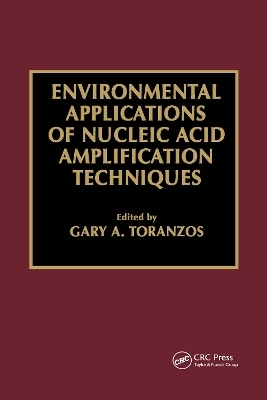
Environmental Applications of Nucleic Acid Amplification Technology
Crc Press Inc (Verlag)
978-1-56676-408-7 (ISBN)
Antibody techniques have allowed us to study microorganisms in situ. However, until recently all methodology lacked the sensitivity necessary for environmental work where microorganisms are in most cases present at very low concentrations or where microbial ecosystems contain a myriad of different organisms. Gene probes have been used successfully for a variety of samples, but this method was still not sensitive enough. The next logical step was the application of the recently developed DNA amplification technique known as the polymerase chain reaction, or PCR. Since then, many laboratories around the world have adopted PCR for environmental work.
Samples obtained from soils, water and air are enormously complex because they are unknown mixtures of DNA and other compounds. Thus, procedures for target DNA amplification from the environment require special attention. The PCR has allowed us to go beyond the need for culturing prior to analysis of microbial communities. It has been shown that even microorganisms that can be routinely grown in the laboratory undergo some physiological changes when exposed to the environment. One of these changes (first observed by R. Colwell and colleagues) is known as the viable-but-non-culturable state, and seems to be a common occurrence. Thus, the use of culture techniques paint only part of the picture in terms of microbial behavior under environmental conditions. The ability to amplify nucleic acids by the PCR has brought about a myriad of very ingenious modifications to the technique that can then be used to study complex ecosystems. The manner in which the PCR can be modified is only limited by the need and/or the imagination of the researcher.
The first manual dedicated specifically to the analysis (by PCR) of environmental samples, Environmental Applications of Nucleic Acid Amplification Techniques presents state of the art methodology for the detection of microorganisms in soil, water, air samples, as well as the amplification of nucleic acids from fossil samples. The manual gives step-by-step procedures for the analysis of these samples. Although several publications have addressed the use of Polymerase Chain Reaction technique, very few of them have been directed toward the application of this technique to environmental samples. This book fills this gap in the literature.
Gary A. Toranzos
PrefaceRequirements for a Nucleic Acid Amplification LaboratoryGary A. Toranzos General Introduction and Literature ReviewAsim K. Bej and Gary A. Toranzos Basic Methodology for DNA and RNA AmplificationAbdiel J. Alvarez and Gary A. Toranzos Assessing Genetic Diversity of Microbes Using Repetitive Sequence-Based PCR (rep-PCR)Frank J. Louws, Maria Schneider and Frans J. De Bruijn Detection of Microorganisms in Soils and Sludges Ian L. Pepper, Timothy M. Straub and Charles P. Gerba Detection of Viruses in Water Samples by Nucleic Acid Amplification Morteza Abbaszadegan and Ricardo de Leon Detection of Giardia Cysts and Cryptosporidium Oocysts in Water Samples by PCRMorteza Abbaszadegan PCR Detection of Airborne Microorganisms Mark P. Buttner, Abdiel J. Alvarez, Linda D. Stetzenbach and Gary A. Toranzos Detection of Legionella and Legionella pneumophila DNA in Environmental Water Samples Using the Polymerase Chain Reaction Teresa Picone, Theresa Young and Elizabeth Fricker DNA Amplification Techniques in Fossilized SamplesRaul J. Cano
| Erscheint lt. Verlag | 1.10.1997 |
|---|---|
| Verlagsort | Bosa Roca |
| Sprache | englisch |
| Maße | 156 x 234 mm |
| Gewicht | 535 g |
| Themenwelt | Informatik ► Weitere Themen ► Bioinformatik |
| Naturwissenschaften ► Biologie ► Genetik / Molekularbiologie | |
| Technik ► Umwelttechnik / Biotechnologie | |
| ISBN-10 | 1-56676-408-4 / 1566764084 |
| ISBN-13 | 978-1-56676-408-7 / 9781566764087 |
| Zustand | Neuware |
| Haben Sie eine Frage zum Produkt? |
aus dem Bereich


